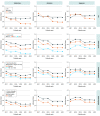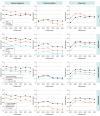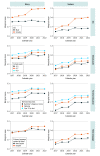Trends in Well-Being Among Youth in Australia, 2017-2022
- PMID: 37606925
- PMCID: PMC10445194
- DOI: 10.1001/jamanetworkopen.2023.30098
Trends in Well-Being Among Youth in Australia, 2017-2022
Abstract
Importance: Little is known about temporal trends in children's well-being and how the COVID-19 pandemic may have influenced the well-being of young Australians. Certain demographic groups may be more vulnerable to experiencing declines in well-being.
Objective: To examine well-being trends over 6 consecutive years among South Australian students and explore the influence of sociodemographic characteristics.
Design, setting, and participants: Longitudinal analyses of annual (2017 to 2022) cross-sectional data of students in grades 4 through 9 (n = 40 392 to 56 897 per year) attending South Australian government schools from the Well-being and Engagement Collection (WEC) census.
Exposures: Calendar year (2017-2022) and sociodemographic characteristics (sex, school grade, parental education, language spoken at home, residential region) from school enrollment records.
Main outcomes and measures: Students self-reported life satisfaction, optimism, happiness, cognitive engagement, emotional regulation, perseverance, worry, and sadness.
Results: Over 6 years (2017 to 2022), a total of 119 033 students (mean [SD] age, 12.1 y; 51.4% male) participated in this study. Most well-being measures declined over time, with consistent worsening of well-being from 2020 onward. For example, compared with 2017, sadness was 0.26 (95% CI, 0.25-0.27) points higher in 2020 (standardized mean difference [SMD], 0.27) and remained elevated by more than 0.26 points (SMD, 0.27) in 2021 and 2022. At almost every time point, greatest well-being was reported by students of male sex (except cognitive engagement and perseverance), in earlier school grades, with highest parental education, speaking a language other than English at home, and residing in outer regional and remote settings (for satisfaction, optimism, and emotional regulation). Sociodemographic differences in well-being were generally consistent over time; however, sex differences widened from 2020 for all indicators except cognitive engagement and perseverance. For example, between 2017 and 2022, sadness increased by 0.27 (95% CI, 0.25-0.29) more points among females than males (SMD, 0.28).
Conclusions and relevance: In this longitudinal analysis of annual census data, there were downward trends in students' well-being, especially since 2020. The largest sociodemographic disparities were observed for students of female sex, those in later school grades, and those with lowest parental education. Urgent and equitable support for the well-being of all young people, particularly those facing disparity, is imperative.
Conflict of interest statement
Figures




References
-
- Pollard EL, Lee PD. Child well-being: a systematic review of the literature. Soc Indic Res. 2003;61:59-78. doi:10.1023/A:1021284215801 - DOI
-
- Frisch MB. Improving mental and physical health care through quality of life therapy and assessment. In: Diener E, Rahtz DR, eds. Advances in Quality of Life Theory and Research; 2000:207-241. doi:10.1007/978-94-011-4291-5_10 - DOI
-
- Huebner ES. Correlates of life satisfaction in children. Sch Psychol Q. 1991;6(2):103. doi:10.1037/h0088805 - DOI
-
- Wang M-T, Degol JL, Amemiya J, Parr A, Guo J. Classroom climate and children’s academic and psychological wellbeing: a systematic review and meta-analysis. Dev Rev. 2020;57:100912. doi:10.1016/j.dr.2020.100912 - DOI
MeSH terms
LinkOut - more resources
Full Text Sources
Medical

